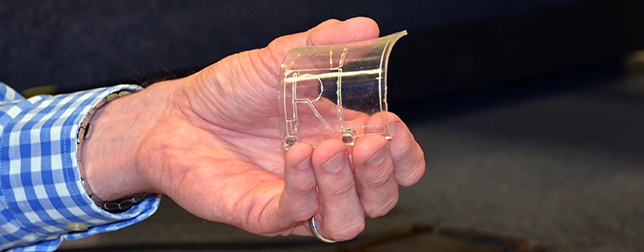We humans aren’t rigid like electronic circuitry, therefore manufacturers need to make a sea of change in order to produce wearables that fit us perfectly.
Among the several stretchable solutions at work, here some of the most innovative and exciting projects to look out for.
Polyera Wove Band, launched in 2015, is a wrist-worn wearable with an E Ink display that folds around your wrist and flattens out when you take it off.
In 2017 Polyera stopped producing the Wove Band after the company folded into a new company called Flexterra. But the technology is still alive and well.
“The special sauce is the transistor material surrounded in an amorphous or polycrystalline based transistor,” says Flexterra CEO Phil Inagaki. “We have organic semiconductors and organic dielectrics which stack up to build the full working transistor.”
“That transistor becomes highly mechanically robust because it’s really made of plastic-like materials whereas other transistors are based on materials like silicon, which are brittle,” says Inagaki.
Read more Stretchable, Bendable Electronic Circuits Could Give Way to Flexible Electronics
Flexterra is currently focusing on display makers. This year, the company revealed a 6.8-inch flexible e-reader in partnership with E Ink earlier this year. But according to Inagaki, this same technology could be used for other purposes including worn displays and sensors. “Now the fundamental materials technologies are proven to work, those are things I think will gain a lot more traction in the next 12-24 months,” he said.
Researchers at RMIT University in Melbourne, Australia are going in a different direction with the same concept. They’re trying to create stretchable, not just bendable sensors.
The process involves heating metal oxide on a bed of platinum and silicon wafer to 400 degrees. Next, a layer of stretchy silicone is added and the silicon wafer is peeled off. Finally, the platinum layer is removed with the help of a gas chamber. What’s left is the metal oxide suspended in the silicone, but it’s a thin transparent film with an embedded circuit.
Dr. Madhu Bhaskaran from RMIT’s School of Engineering decided to look at the stretchy material under a microscope, and discovered a “micro-tectonic” effect. Rather than breaking after a stretch, the metal oxide formed plates that slid over each other, maintaining their integrity.
Read more Are Sensors Going to Revolutionize Healthcare?
After testing this technology with sensors for monitoring UV levels and identifying harmful gases, the team found that the stretchy substrate will let them adhere to your skin much more comfortably than current designs.
“I could see UV sensors being deployed in six years’ time but other applications might take longer as they also depend on regulations and so on,” says Bhaskaran.
The concepts around stretchable sensors go back several years. In 2005, John A. Rogers of Northwestern University’s School of Engineering published a paper on flexible silicon electronics.
Rogers now works with the Shirley Ryan AbilityLab. He and his team are trying to develop a series of stretchable sensors that look a little like plasters. They can be placed on the forearm, neck, and legs to allow healthcare professionals monitor the rehabilitation patients with stroke and traumatic injury.
“Stretchable electronics allow us to see what is going on inside patients’ bodies at a level traditional wearables simply cannot achieve. The key is to make them as integrated as possible with the human body,” says Rogers.
Tacterion, a startup promoting stretchable sensor technology, makes SensorSkin, a rubbery foil that acts as both a resistive and capacitive touch sensor. Initially developed by co-founder Michael Strohmayr at the German Aerospace Center, SensorSkin’s capacitive component can also detect your hand hovering above it.
“If, some day, people are playing with the next-generation controller of a gaming console saying ‘Tacterion inside’ at home, or their cars carrying a label reading ‘Tacterion inside’,” says Daniel Strohmayr, “we would be extremely pleased.”













